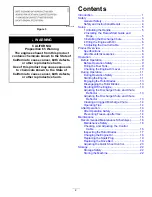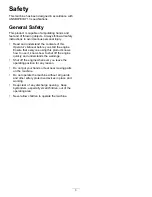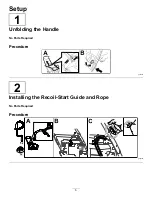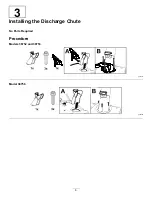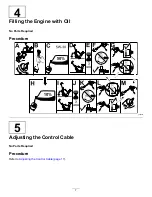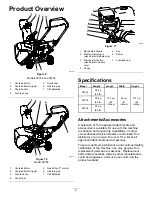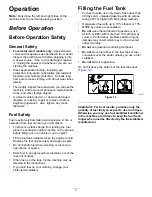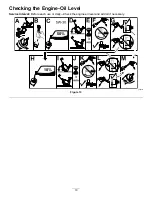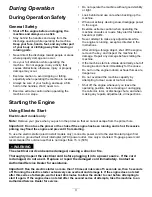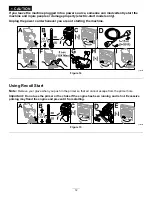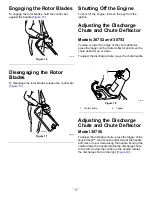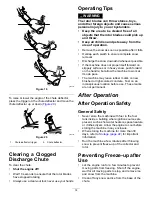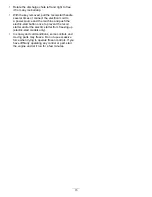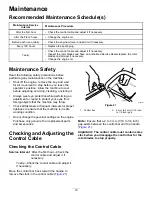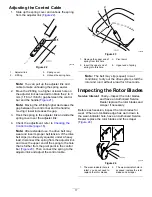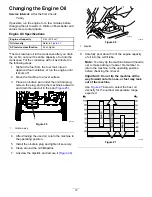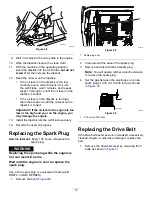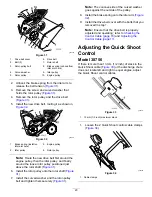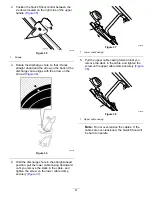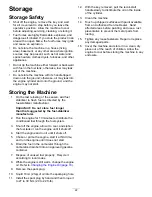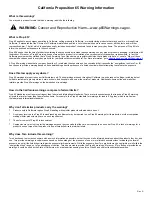
During Operation
During Operation Safety
General Safety
•
Shut off the engine before unclogging the
machine and always use a stick.
•
Stay behind the handles and away from the
discharge opening while operating the machine.
Keep your face, hands, feet, and any other part
of your body or clothing away from moving or
rotating parts.
•
Never direct the discharge toward people or areas
where property damage can occur.
•
Use your full attention while operating the
machine. Do not engage in any activity that
causes distractions; otherwise, injury or property
damage may occur.
•
Exercise caution to avoid slipping or falling,
especially when operating the machine in reverse.
•
Always be sure of your footing, and keep a firm
hold on the handles. Walk; never run.
•
Exercise extreme caution when operating the
machine on a slope.
•
Do not operate the machine without good visibility
or light.
•
Look behind and use care when backing up the
machine.
•
When not actively clearing snow, disengage power
to the auger.
•
Exercise extreme caution when operating the
machine on walks or roads. Stay alert for hidden
hazards or traffic.
•
Never attempt to make any adjustments while
the engine is running, except as directed in the
instructions.
•
After striking a foreign object, shut off the engine,
remove the key, and inspect the machine for
damage. Repair any damage before starting the
machine.
•
If the machine starts to vibrate abnormally, shut off
the engine and check immediately for the cause.
•
Do not run the engine indoors; exhaust fumes are
dangerous.
•
Do not overload the machine capacity by
attempting to clear snow at too fast a rate.
•
Shut off the engine whenever you leave the
operating position, before clearing or unclogging
the collector, rotor, or discharge chute, and when
making any repairs, adjustments, or inspections.
Starting the Engine
Using Electric Start
Electric-start models only
Note:
Remove your glove when you push in the primer so that air cannot escape from the primer hole.
Important:
Do not use the primer or the choke if the engine has been running and is hot. Excessive
priming may flood the engine and prevent it from starting.
To use the electric starter (electric-start models only), connect a power cord to the electric-start plug-in first
and then to a ground fault circuit interrupter (GFCI) power outlet. Use only a UL-listed, 16-gauge power cord
recommended for outdoor use that is not longer than 15 m (50 ft).
WARNING
The electrical cord can become damaged, causing a shock or fire.
Thoroughly inspect the electrical cord before plugging it into a power source. If the cord
is damaged, do not use it. Replace or repair the damaged cord immediately. Contact an
Authorized Service Dealer for assistance.
Important:
Run the electric starter no more than 10 times at intervals of 5 seconds on, then 5 seconds
off. Running the electric starter extensively can overheat and damage it. If the engine does not start
after this series of attempts, wait at least 40 minutes to allow the starter to cool before attempting to
start it again. If the engine does not start after the second series of attempts, take the machine to an
Authorized Service Dealer for service.
11
Summary of Contents for Power Clear 721
Page 24: ......


